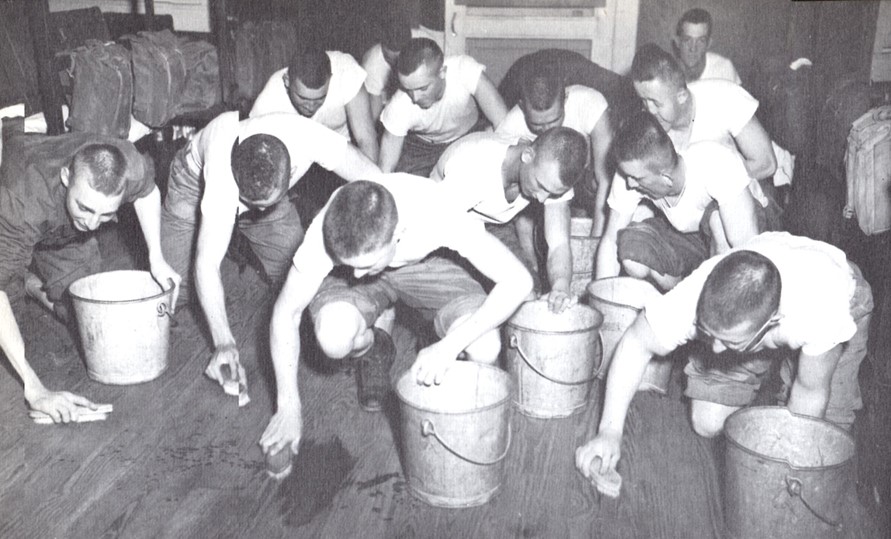Our first destination was the barber shop where we would lose our civilian coiffures. Since I had sported a flattop all through my teen years, I was set to lose a good deal less hair than many of my compatriots, and unlike the time-consuming and careful haircuts we were accustomed to in civilian life, the shearing that evening took only a matter of about thirty seconds as the razors were obviously set at their lowest setting and the barbers, who probably sheared sheep in their everyday lives, moved the razors from one side of our heads, front to back, across the top and to the opposite side, leaving each of us as close to being ‘skinheads’ as possible without the use of a straight razor.
The entire busload of individuals was completed in well less than half an hour, with two or three barbers working their magic.
A good deal of the first days is a blur and the following description of events may not occur exactly as they happened, but they were there at some point.
Since we had arrived at night, we were taken to temporary barracks for the rest of the night. I can’t recall when I had eaten before arriving, but we were not offered anything that night before being told to bed down. With everything happening so quickly I doubt that any of us thought or cared much about eating. I know that I was asleep quickly.
The next morning we were rousted very early by the shouts of Drill Instructors demanding that we ‘hit the deck’ and come to attention.
I stood, in my underwear — from this point on to be referred to as “skivvies” — at the foot of the bed — from this point on to be referred to as a “rack” — at rigid attention.
Bad idea.
The next thing I remember is awakening on the floor, halfway under my assigned rack, with a drill instructor looking down on me and inquiring about my health. With a bit of help I worked myself into an erect position, probably only halfway at attention with the whispered admonition in my ear, “Don’t lock your knees!” I never did again.
We were shuffled off to morning chow – take all you want, eat all you take – for a repast that would become familiar in the following months. I don’t recall if we were offered chipped beef on toast (shit-on-a-shingle) that morning or not, but it would be a staple on many mornings to come. And that meal would be the beginning of a daily intake that would add fifteen pounds to my frame in the next thirteen weeks.
I had arrived at the island a six-foot-two-inch lad weighing a slim 155 pounds.
Then it was off to receive our clothing. This would not be uniforms in the strict sense of the word since our formal uniforms of tropicals and greens would not come until near the end of boot camp because so many of us would undergo dramatic physical change in the next weeks. Instead, we were given skivvies (military-issued underwear which consisted of white tee shirts and white boxer shorts which had fabric ties on each side to adjust the waist length to our changing physiques. We also received ‘utilities’, the outer work clothes which would carry us through every aspect of our training, along with boots, ankle-height shoes called “boondockers,” olive-drab socks, and billed caps which could be folded and placed in one’s back pocket when not actually being worn.

With the possible exception of our footwear and caps, hereafter to be referred to as ‘covers’, everything seemed to come in two sizes, too small and too large. And so we were also provided with sewing kits to make the necessary adjustments. Imagine a room full of guys, most of whom had never wielded a needle and thread, trying to make minute adjustments in the length of their trousers!
We also received, along with our work clothing, numerous other items to carry us through boot training including shaving gear which consisted of a double-edged safety razor and a cup with soap for lather, bar soap, wash cloths, towels, a three-gallon bucket with scrub brush. The bucket would serve multiple purposes such as aiding in washing our clothing and scrubbing the barracks floors.

The wash racks shown here are constructed of concrete. They have a cold water line running down the middle with spigots on both sides. On specified wash days we would wash all soiled skivvies and utilities and hang them to dry on clothes lines behind the barracks. One of our number was assigned to watch over the items to deter any shenanigans from other platoons. The South Carolina sun dried everything in quick time.
We also were given what is generally known as a duffle bag. In the Marine Corps and Navy, this is a “sea bag” and is used to carry EVERYTHING we own from one duty station to the next.
And, with all our gear in hand, we were marched – still not quite an accurate description of our uncoordinated shuffling – to the barracks that would be ours until time to move to the rifle range in a few weeks.



